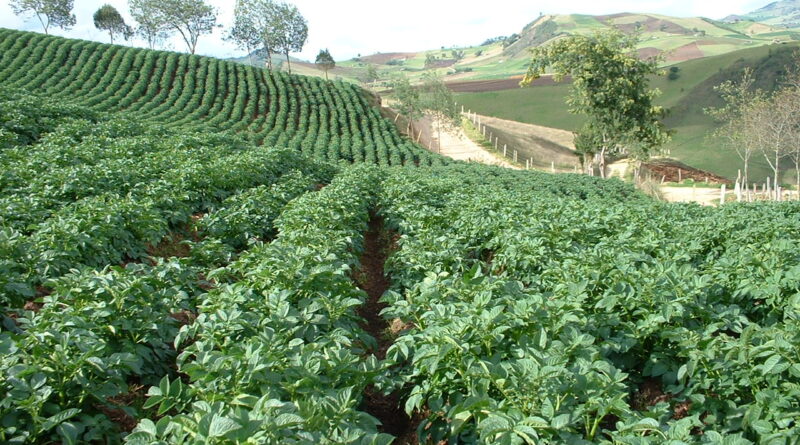Foliar feeding the African potato crop By Dr Terry Mabbett

Sub Saharan Africa is not automatically associated with the cultivation of the Irish potato (Solanum tuberosum), but crops are grown on a significant scale from the irrigated fields in South Africa to the tropical highland zones in countries like Kenya and Zambia. Potato production is growing faster in Africa than any other region of the world with Malawi (4.5 million tons), South Africa (2.3 million tons), Rwanda (2.2 million tons) and Kenya (2.2 million tons) currently the biggest players in Africa south of the Equator.
The potato crop is pivotal on the tuber as the planting material, as an underground food accumulation organ and as the harvested, stored and consumed crop commodity. And being a stem tuber rather than a root tuber Solanum tuberosum is virtually unique in these respects.
The potato plant’s capacity to initiate, form and grow tuberous organs is the key reason why this Solanaceous crop has such a well-structured and definitive cycle of plant growth and development. And particularly so because potato tubers, though forming and growing underground, are not root tubers but stem tubers bearing buds (eyes). And therefore possessing the capability to produce roots, shoots and photosynthesising leaves; and as such an independent new plant.
Everything about the potato plant ‘stems’ from the tuber, so when it comes to crop nutrition, with tubers as centrepiece, a similarly well-structured set of nutrient requirements is immediately presented. And thus demanding a formalised fertilizer programme more precisely profiled and programmed than for any other field crop. What’s more the high ‘Leaf Area Index’ with plant canopies meeting in the rows to present complete foliar cover for incoming spray droplets makes potato the ideal crop for foliar feeding with soluble nutrients.
So many distinct stages in the crop cycle potato demand a comprehensive portfolio of products offering the full complement of essential plant nutrients at specific times in the crop cycle. Omex Agrifluids an R & D focussed company with headquarters (R & D, manufacturing and marketing) at Kings Lynn in eastern England (United Kingdom) is one company with the necessary credentials. So I travelled to Kings Lynn to meet with Dr Ben Odunlami Technical Sales Manager for Africa and Oskar Winkler Export Sales Manager for Africa to discover their take on foliar feeding for the burgeoning potato crop in Sub Saharan Africa.
Best and logical way to approach foliar feeding of crops like potato with distinctive developmental stages is to start from the beginning. “We recognise five distinct stages in the potato crop cycle” says Ben Odunlami listing ‘tuber germination’, ‘emergence from the soil’, ‘tuber initiation and set’, ‘plant flowering’, ‘tuber bulking’ and ‘skin set’ in that order.
Tuber germination
Germination is a term usually reserved for seeds but functionally this is precisely what planted potato tubers are. Germination in the potato context covers the period from when tubers break dormancy and initiate first roots, accompanied by ‘breaking’ buds (eyes) and shoot growth. However, for commercial purposes dormancy will have already been broken prior to planting because tubers are chitted (shoot growth encouraged) for an extra quick getaway in the soil.
Be that as it may germination is a critical phase for tubers as the earliest stage of growth and clearly vulnerable to a whole range of abiotic (e.g. high salt levels and drought) and biotic factors, and particularly pathogens (fungal and bacterial) which may be soil-borne or carried into the soil on seed potato tubers. As such the germination phase needs to be as brief as possible which can only be achieved if growth and establishment is as rapid as possible.
I asked Oskar Winkler about the Omex products designed and developed for this ‘starter’ stage in the potato crop. “First up is Omex Biomex Plus a soil amendment product for in-furrow spray application to the tubers at planting,” said Oskar. “This is a unique Omex product with biological activity provided by the beneficial bacterium Bacillus amyloliquefeciens, a completely natural and ‘unreconstructed’ soil-borne, root colonising bacterium with antagonistic properties against plant pathogens”, Oskar Winkler told Arab World Agribusiness.
The bacterium develops integrally with newly developing root systems to enhance resilience to negatively impacting abiotic factors while acting antagonistically against plant pathogenic microbes. “Some benefits are seen almost immediately,” says Ben Odunlami, “in faster tuber germination with more root development, and much further ‘down the line’ in earlier harvests and higher yields of healthier potatoes.”
The biologically active formulation is complemented with key nutrients as potassium, copper, zinc and manganese and phosphorous, but as phosphite rather than phosphate, and to provide a pool of nutrients for potato roots to tap into. “The phosphite is especially important at this stage because of its synergistic activity. Phosphite assists in the uptake, movement and utilisation of other nutrients while heightening the plant’s resilience to attack by fungal and bacterial pathogens,” says Oskar Winkler. Rate of product application is 2.5 l/ha.
Emergence from the soil
Describes and covers the following and equally critical stage starting when shoots push through the soil surface and the first leaves form, thus taking the potato plant into another milestone stage of the crop cycle. Thereon potato plants proceed with growth moving from reliance on tuber reserves to light-energised synthesis of glucose via photosynthesis. From now on, speed of foliar growth and leaf expansion is the key to future success of the potato crop.
Recommended for this early stage in crop growth is a unique seaweed ‘inspired’ product designed and developed by Omex. Omex Bio 20 furnishes a full range of nutrients in-tandem with naturally-sourced biostimulant activity. It is a highly concentrated emulsion of macronutrients and chelated micronutrients with an organic constituent derived from a specific marine alga (seaweed). “Plant hormonal actives derived from the seaweed synergise uptake, movement and utilisation of nutrients to energise root development,” says Ben. Recommendations are for 1-2 applications at 2.0 l of product per hectare as a foliar spray.
Tuber initiation and set
While potato plants continue to grow at a rapid rate, with canopies closing across the rows, the most critical ‘moment’ in the crop cycle is happening underground and on which depends the success or failure of the potato tuber harvest.
The events are tuber initiation and tuber set starting when tubers form at the tips of the stolons (underground stems). However, tuber set is what actually determines the proportion of initiated tubers growing and developing into mature and marketable plant organs. Numbers and relative sizes of tubers required by growers will depend on whether the harvested crop is going for ‘ware’ (food) or ‘seed’ (planting). Generally speaking a seed potato grower is looking for larger numbers of smaller-size tubers while a ware crop grower wants larger-sized tubers and by consequence less in number.
Tuber initiation and the stage is set for entry of Omex Zynergy, one the newest products developed by Omex Agrifluids. “Omex Zynergy is a unique complex of copper (2.11% w/v) and zinc (3.75% w/v) which corrects any deficiencies and improves plant health and tolerance to abiotic stress. Zinc and copper have key roles in tissue integrity and disease suppression. Zinc plays a major role in the structure and function of integumentary system which affects skin elasticity, wound healing and disease suppression. Copper complements zinc activity by activation of enzyme systems and as a component of the phenolic compounds used by plants to suppress infections,” Oskar Winkler told Arab World Agribusiness. Foliar sprays starting at tuber initiation and repeated every 10-14 days using 0.5 l/product/ha are recommended.
Plant flowering
Next stage is flowering of no direct economic effect and consequence but nevertheless another milestone and key stage in the crop cycle. And due to its impact and influence on vegetative growth when plant resources are diverted into flower production and fruit set.
Foliar growth has now reached its limit. The crop canopy has ‘closed’ across the rows and plants have stopped producing new leaves. Soluble carbohydrate and nutrients are directed down into developing tubers to create a ‘double drain’ (flowering and tuber development) on above ground resources. At this time growers need to bolster plants with particular nutrients including magnesium (key structural component of the chlorophyll molecule), calcium (crucial for cell wall integrity) and potassium (gate-keeper nutrient for good water relations at cell and tissue levels).
Beginning during tuber initiation and set and extending through plant flowering there is a heavy strain and drain on the potato plant which requires bolstering. So, I asked Ben and Oskar what Omex has to offer potato growers in the way of broad-based nutrient products.
“Omex K41 will more than meet the plants’ requirements for potassium at these times. At 41.00% w/v potassium Omex K41 furnishes the potato crop with potassium which has such a vital role in maintaining good water relations, controlling stomatal movements and in the transport of sugars from the leaf to be stored in the tuber as starch,” Oskar told Arab World Agribusiness. Recommended rate is 2.0 – 3.0 l product/ha. In countries where Omex K41 is not available potato growers can use Omex Sequential 2 (40.00% w/v potassium) at 1.0 – 2.0 l/ha.
These three products are used as foliar sprays throughout the period from tuber initiation and set and throughout the plant flowering stage.
Bulking and tuber skin set
Tuber cells expand as water soluble carbohydrates and nutrients accumulate during this longest-duration and critical phase of the potato crop cycle. And if poorly conducted it will curtail what would otherwise have been a high yielding crop of potatoes. Two Omex products are on hand to see the potato crop successfully through this final critical period when the tubers are most susceptible to disease. This is the time to apply those nutrients with strengthening and disease suppression credentials.
Omex CalmaxB which contains calcium 22.5% w/v; boron 1.53% w/v plus chelated micronutrients, nitrogen and magnesium is applied as a foliar spray at 2.0 l/ha).
Calcium is the prime strengthening element. It has a structural role in calcium pectate to form the middle lamella which cements the plant cell walls together. Boron plays a key role in the synthesis of cell wall material as well as its involvement in the transport of sugars.
Last but not least is Omex Zibo also containing boron but twinned with zinc with that micronutrient’s established credentials in promoting tuber wound healing and disease suppression.
Calcium, boron and zinc are the most cited nutrients when it comes to reducing disease in potato crops. These critical nutrients play a vital role in forming robust protection against disease and other defects within the plant, and growers trying to get the most from their potato crop should not underestimate their importance.
The End
06 March 2024

